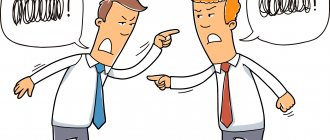Professional deformation leads to changes in people's behavior. Has it ever happened to you that, after meeting a person and talking with him for a short time, you could easily guess his occupation? Characteristic professional traits are especially evident in those who work with people. For example, you can get to know a teacher out of habit by not just explaining something, but by doing it in great detail.
The famous Russian scientist Rada Mikhailovna Granovskaya wrote about the psychology of professional personality deformation: “The professional role has a multifaceted impact on the personality, placing certain demands on a person, thereby transforming his entire appearance. Daily, over many years, solving typical problems improves not only professional knowledge, but also forms professional habits, determining the style of thinking and style of communication.”
What is professional deformation
The concept of professional personality deformation was first used by sociologist Pitirim Sorokin back in the last century. He noticed this phenomenon while studying the work of teachers. This is where the study of changes provoked by long periods of work in one place began.
Professional deformation - what is it? This is the transfer of professional skills into everyday life. During its development, there is a significant change in personal qualities that develop as a result of prolonged performance of stereotypical work duties. Peculiarities of perception and behavior and even human values are touched upon.
Main reasons for development
Occupational deformations have a number of causes. The key among them is prolonged stagnation (stagnation of growth). It occurs when a person reaches certain heights in work activity and stops moving forward to something new. Can develop in any job involving repetitive activities. Even the most prestigious positions do not save us from the onset of stagnation. Therefore, professional deformation of a leader’s personality is not uncommon.
Other factors of professional deformation:
- continuous monotonous work;
- regular stressful or conflict situations;
- increased levels of nervousness or fatigue;
- lack of prospects for further professional growth;
- regular excessive workload in the workplace.
It takes some time for psychological professional deformation to develop. But there are two reasons for its appearance at a young age:
- A novice worker has high expectations regarding the profession. Disappointed, he gives up and switches to uninitiated fulfillment of obligations. Not accompanied by a creative approach and variety of actions, it quickly leaves its mark on the personality.
- A young specialist does not choose an activity because of its characteristic features. He is guided by other motives. This may be a desire to achieve power or to prove one’s social significance to someone. Therefore, a person treats the actions performed without interest, does not develop and quickly falls under the processes of deformation.
Signs of approaching deformity
Alarm bells in human behavior indicating the onset of changes are:
- placing your profession on a pedestal;
- identification of oneself as a person with labor achievements;
- panic fear of losing your existing job;
- limiting your social circle to colleagues and co-workers;
- attitude towards the environment of acquaintances as potential objects of the labor sphere of activity;
- limiting interests to work issues;
Another sign is difficulty communicating with friends and family. They arise due to the frequent use of professional terms and conversations about work.
Stereotypes
- The stereotype “a boss must be tough-skinned, firm, persistent” changes the structure of managerial interaction, transferring it to a mode of threat of punishment for misconduct, orderly communication.
- The stereotype “the boss is always right” negatively affects the employee’s independence of decisions and judgments, creates lack of initiative, and expectation of orders and instructions from management.
- The stereotype of dogmatic adherence to orders gives rise to an attitude of mindlessly following any order from the boss, often leading to intrapersonal conflicts if one has one’s own opinion about the need to act differently.
- The stereotype of the “little man” leads to a decrease in professional self-esteem, the manifestation of conformity and the absence of one’s own judgments on this or that official issue.
- The stereotype of “optimal” role behavior often acts as a mechanism of adaptive behavior to certain work situations and specific professional actions. Thus, threatening and aggressive behavior is considered as optimal for obtaining evidence from a suspect, etc.
- The stereotype of “finding the culprit” justifies all actions to find the culprit, punish him, etc. At the same time, work to identify the true causes of ineffective activity fades into the background, and its shortcomings are not revealed.
In general, non-professional usage, the term professional deformation
is used in a weaker sense, indicating (often ironically) only a certain influence of professional habits on people’s behavior in private life, the transfer of specifically professional stereotypes and attitudes to behavior outside of work.
Types of professional deformation
There are several main types of personality changes:
- General professional. This includes excessive manifestations of the characteristics of the specialty in everyday life. For example, police officers describe this type as the perception of everyone they meet as a potential attacker.
- Individual. They are determined by personality characteristics, and not by professional activity. They represent the development of a person’s inclinations in fertile soil in the form of the characteristics of the work he performs. This creates excessive responsibility for accountants.
- Typological. They are formed by the fusion of professional and personal qualities. For example, they manifest themselves in the development of organizational abilities while working as a primary school teacher. In a positive way, they manifest themselves in the ability to quickly plan any event. With a negative course of deformation, an excessive love of commanding other people as one’s own students is possible.
In each case, occupational deformation depends on the type of work and the time spent on it.
What is professional deformation expressed in?
The main form of manifestation is passing everything that happens through the prism of labor knowledge and skills. Work is placed on a pedestal by a person and often arises in everyday home life. May lead to a revision of values and a change in personal qualities. Social professional deformation of personality entails changes in behavior. For example, having taken a respectable position, a person begins to behave arrogantly.
Another form of professional deformation is a change in social circle.
Causes
One of the most common causes of professional deformation, according to experts, is the specifics of the immediate environment with which a professional specialist is forced to communicate, as well as the specifics of his activities. Another equally important reason for professional deformation is the division of labor and the increasingly narrow specialization of professionals. Daily work, over many years, to solve standard problems not only improves professional knowledge, but also forms professional habits, stereotypes, determines the style of thinking and communication styles.. In the psychological literature, three groups of factors leading to the occurrence of professional deformation are distinguished: factors, conditioned by the specifics of the activity, factors of a personal nature, factors of a socio-psychological nature
In the psychological literature, three groups of factors leading to the occurrence of professional deformation are distinguished: factors determined by the specifics of the activity, factors of a personal nature, factors of a socio-psychological nature.
Examples of manifestations of professional deformation
| Speciality | Manifestations of deformation associated with the specifics of work |
| Doctor | Automatic assessment of health status and distribution of advice on improving it without asking. Focus on the pulse during a simple handshake. Analysis of skin color, cough pattern, etc. |
| Stylist | An appraising look and comments about appearance without prior request. Mental representation of the interlocutor in different images, selection of a new image. |
What does professional deformation entail?
Based on the nature of the changes, different levels of professional deformation are distinguished:
- Physiological. Changes in the body associated with the way of acting in the workplace. For example, sedentary work leads to a slower metabolism and excess weight gain.
- Psychological. They include all behavioral features caused by the specifics of the position held. For example, teachers may often lecture or speak in a raised voice in everyday life.
Moral and professional deformation of the individual can manifest itself in a constructive or destructive way. With positive development, improvements occur. For example, a person becomes punctual and responsible. But here it is important to remember that with severe deformation, the line between adequate and excessive manifestation of these tendencies is very thin.
In the case of a negative scenario, changes for the worse are observed. They entail problems in relationships with loved ones. It is also possible for a person to shift the boundaries of what is permitted. For example, taking advantage of his official position, a person turns into a corrupt official.
Vocational rehabilitation
A return to an adequate perception of life is possible thanks to the following activities:
- Preventive measures regarding problems with adaptation of newcomers to the profession.
- Courses and trainings on personal growth.
- Consultations with a psychologist.
- Increasing socio-psychological awareness through useful self-study materials.
- Training.
Another way to recover is to create a career development plan.
Examples
Real life examples will help you better understand what professional deformation is. Since people who work with people are more susceptible to them, first of all, teachers, health workers, and lawyers are at risk.
The professional deformation of the teacher is expressed in pickiness towards the flaws and mistakes of others, and the habit of commanding the environment. They biasedly monitor the actions and behavior of relatives, friends, and acquaintances. Sometimes they can even give them marks.
In everyday life, health workers involuntarily analyze the health status of their interlocutors, often finding diseases that correspond to their specialization. Despite the fact that medical etiquette forbids them to report a diagnosis made by eye, they cannot free themselves from this inclination.
However, the appearance of indifference, cynicism, and rudeness towards patients is considered more serious and dangerous. This arises due to the specific nature of the work of health workers, who are constantly faced with human pain, suffering, various incurable illnesses, and death.
Similar indifference, callousness, cynicism, as well as excessive aggression, directiveness, and insensitivity affect law enforcement officials who, due to the nature of their work, are constantly faced with negativity, human pettiness, anger, lies and other vices.
Designers really like to give advice and speak up when their opinion is not sought, since giving out unsolicited recommendations is not prohibited by their professional etiquette. Therefore, they often do not hesitate to cross the boundaries of their sphere.
Stylists often feel stressed just walking down the street and seeing someone's futile attempts to look fashionable. They are similar to doctors; they also notice the slightest flaws, only not in a person’s health, but in his external image.
Webmasters, when visiting someone else’s web resource, cannot disable the “ability” to biasly evaluate competitors’ interface. They are convinced that they could have done much better.
Prevention of occupational deformities
The best prevention of professional deformations is the ability to separate work and personal life. You shouldn’t drag reports and telephone conversations into your kitchen. If your profession requires training at home, set up a separate workplace. When you get up from your desk, stop mentally continuing to solve business problems.
Leisure planning also plays a huge role. Switching attention, changing the environment and type of activity has a beneficial effect. It is important to come up with a hobby that is far from your main occupation. In addition, skill decompensation will have a beneficial effect. As a leader, sometimes allow family members to make choices for you at home and compromise more often.
Useful literature on the topic
Reading specialized literature will help you cope with professional deformation. There are several examples:
- Alexander Asmolov “Personality Psychology”;
- Olga Polyakova “Psychohygiene and prevention of professional personality deformations”;
- Aelita Markova “Psychology of Professionalism”;
- Ewald Zeer “Psychology of Professions”;
- Evgeny Ilyin “Emotions and feelings.”
Thoughtful reading and practical application of advice returns interest in work activities and teaches you to separate your personal and professional lives.
Notes
- Granovskaya R. M.
Elements of practical psychology. - 6th. - St. Petersburg: Rech, 2010. - 560 p. - ↑
- Psychology of professionalism // Markova A.K. “Knowledge”, 1996
- Channel “Culture”, program “Observer” from 09.20.2012 (see from 38.40), artist Sergei Tyunin.
- Definition of "administrative delight" in Wiktionary
- Rogov E.I.
Personality in teaching activities. - Monograph. - Rostov-on-Don: Rostov Pedagogical University, 1994. - 340 p. - Rogov E.I.
Psychology of the formation of professionalism. - monograph. - Rostov-on-Don: Southern Federal University, 2016. - 340 p. — ISBN 978-5-9275-1931-6. - Druzhilov S.A.
Professional deformations and destruction as a consequence of distortion of psychological models of profession and activity // Journal of Applied Psychology. - 2004. - No. 3. - P. 56-62. - Druzhilov S.A.
Professionally destructive activity as a manifestation of professional marginalization and deprofessionalization // Bulletin of Moscow University. Episode 14: Psychology. - 2022. - No. 2. - P. 45-63.










